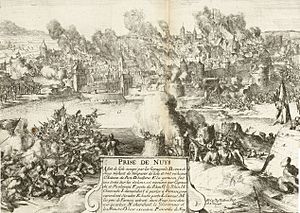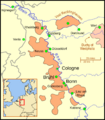Destruction of Neuss facts for kids
Quick facts for kids Destruction of Neuss |
|||||||
|---|---|---|---|---|---|---|---|
| Part of the Cologne War | |||||||
 Great city fire after the siege of Neuss. |
|||||||
|
|||||||
| Belligerents | |||||||
| Commanders and leaders | |||||||
| Strength | |||||||
| Garrison: 1600 Dutch and German Artillery: none |
Troops: 8000 infantry, 2000 cavalry Artillery: 45 |
||||||
| Casualties and losses | |||||||
| Garrison: no known survivors Civilian and military dead: 4000+ |
< 500 | ||||||
The Destruction of Neuss happened in July 1586. It was a major event during the Cologne War. Alexander Farnese, the Duke of Parma, led his troops to surround the city of Neuss. Neuss was an important Protestant stronghold in the Electorate of Cologne.
The city refused to give up. Parma's army then attacked it fiercely. They used powerful cannons and fought house-to-house. A huge fire started during the battle. This fire destroyed most of the city. About 3,000 civilians died, out of a population of around 4,500. The entire group of soldiers defending the city was also killed.
Contents
Why Neuss Was Attacked in 1586
Neuss was taken over by supporters of the Protestant Prince-Elector Gebhard Truchsess von Waldburg in February 1586. Adolf, Count of Moers and Neuenahr, helped strengthen and supply the city. He then moved most of his soldiers north.
He left a young commander named Hermann Friedrich Cloedt in charge of Neuss. Cloedt had about 1,600 soldiers. Most were German and Dutch. Some had battle experience, but many were new recruits.
A hundred years before, Neuss had successfully defended itself. It survived a long siege by Charles the Bold of Burgundy. Because of this, the emperor gave Neuss special rights. These included the right to make its own coins.
Parma's Powerful Army Arrives
In June 1586, the Duke of Parma's army arrived. They surrounded the city's defenses. Parma had strong allies with him. These included Karl von Mansfeld, Francisco Verdugo, and Salentin VII of Isenburg-Grenzau.
Parma's army was very impressive. He had about 8,000 foot soldiers and 2,000 cavalry (soldiers on horseback). These were experienced Italian, Spanish, and German fighters. He also had 45 cannons. Parma placed these cannons on a hill near the city walls.
Before attacking, Parma asked the city to surrender. The city politely refused. As Parma's messenger left, the townspeople shouted insults. The next day was a special holiday for the Spanish. So, the battle did not begin.
The Battle for Neuss
The cannon attack started soon after. Parma's 45 cannons fired for 30 hours. They shot heavy iron cannonballs. In total, 2,700 cannonballs hit the city walls. The Spanish army tried to attack several times, but they were pushed back.
On the ninth attempt, the outer wall was finally broken. Soldiers rushed into the city. Italian soldiers entered from one side, and Spanish soldiers from the other. They met in the city's main marketplace.
Fierce Fighting and Fire
Cloedt, the city's commander, was badly wounded. His leg was almost torn off, and he had five other serious injuries. He was carried into the town. Spanish and Italian forces entered the town from opposite ends. They met in the middle.
Soldiers found Cloedt and killed him. Many other defending soldiers were also killed. The attacking soldiers went through the city. They killed the remaining defenders, even those who tried to surrender.
Women had sought safety in some churches. They were initially spared. But when the fire started, they were forced into the streets. Many civilians, including women, children, and older people, tried to escape the flames. However, they were caught by the soldiers.
Parma wrote to the King of Spain that over 4,000 people died. English observers agreed with this report. They added that only 8 buildings were left standing in Neuss.
What Happened After the Battle
Parma had captured the city. However, his Protestant enemies found some comfort. The city was completely destroyed. It could not be used as a military base anymore.
But this was not a "Pyrrhic victory" for Parma. A Pyrrhic victory is one where the cost is too high. Parma lost fewer than 500 of his own soldiers. The Protestant rebels lost a very important location. They also lost one of their brave young commanders, Cloedt.
After this victory, Parma could easily access the northern parts of the Electorate. This area was called the Niederstift. From there, he could plan attacks on the rebellious provinces of the Netherlands. Gebhard gave up his claim to the Electorate in 1588. Even though Ernst of Bavaria now controlled the area, Parma continued to take and strengthen towns nearby.
Images for kids
See also
 In Spanish: Destrucción de Neuss para niños
In Spanish: Destrucción de Neuss para niños



